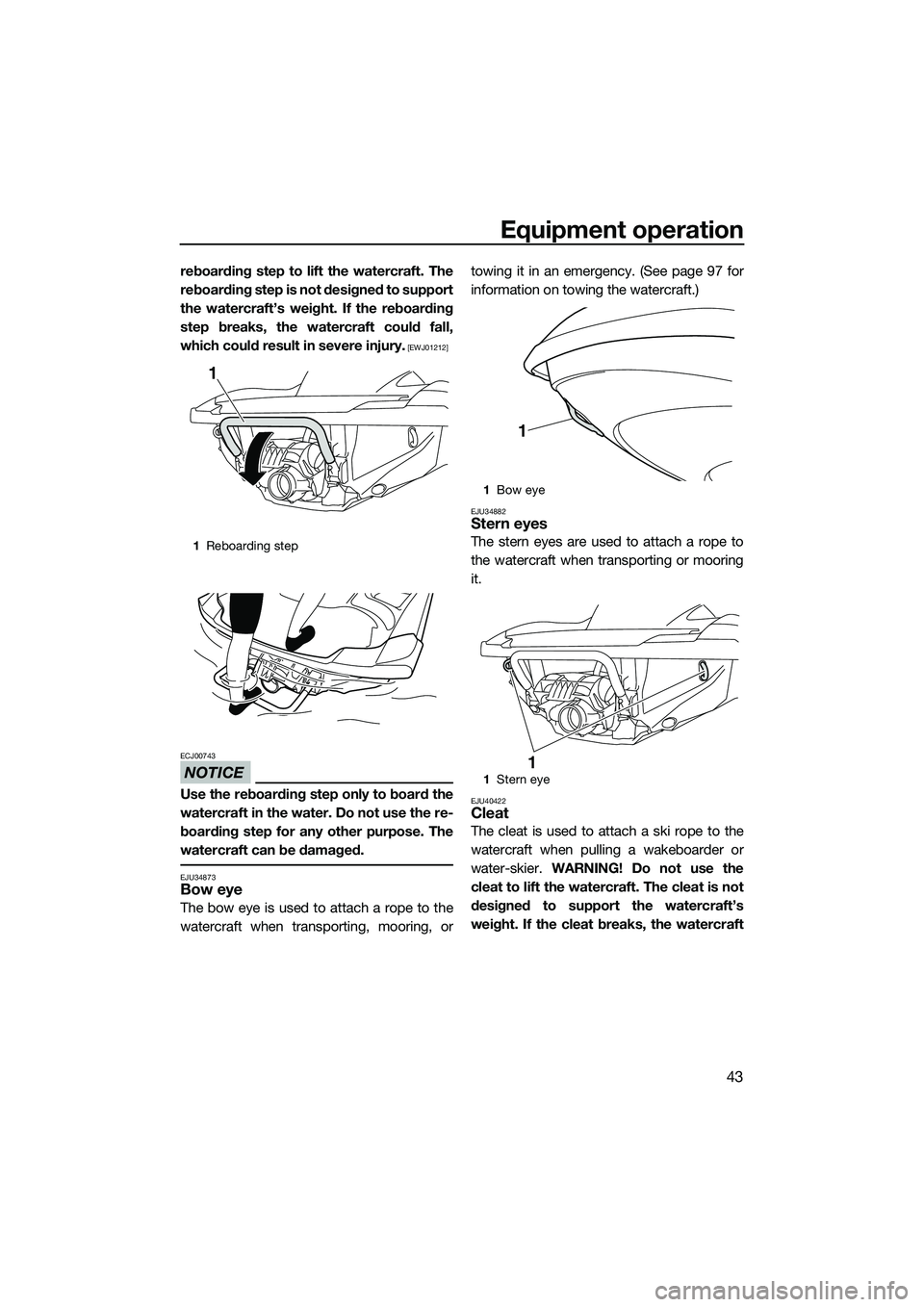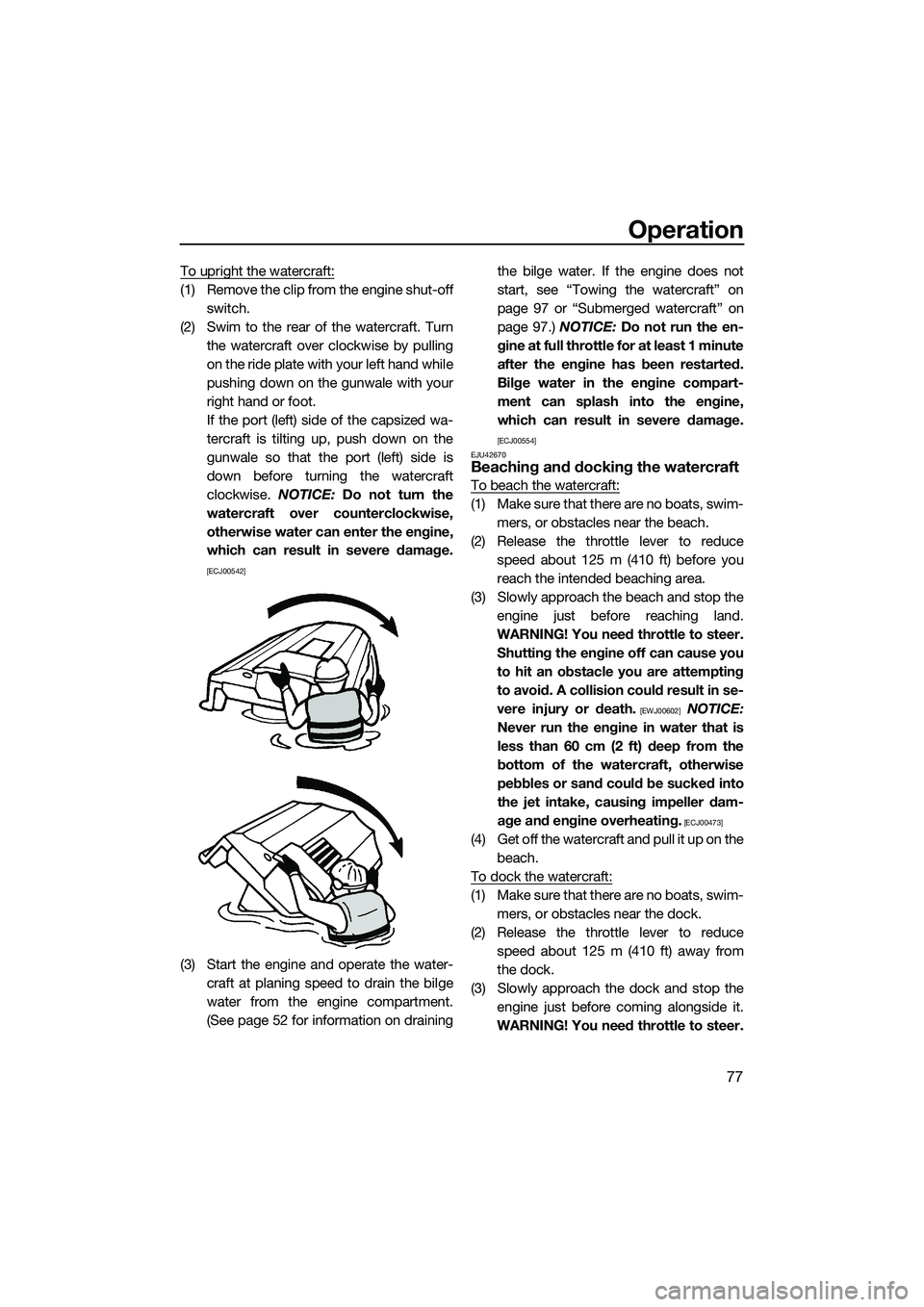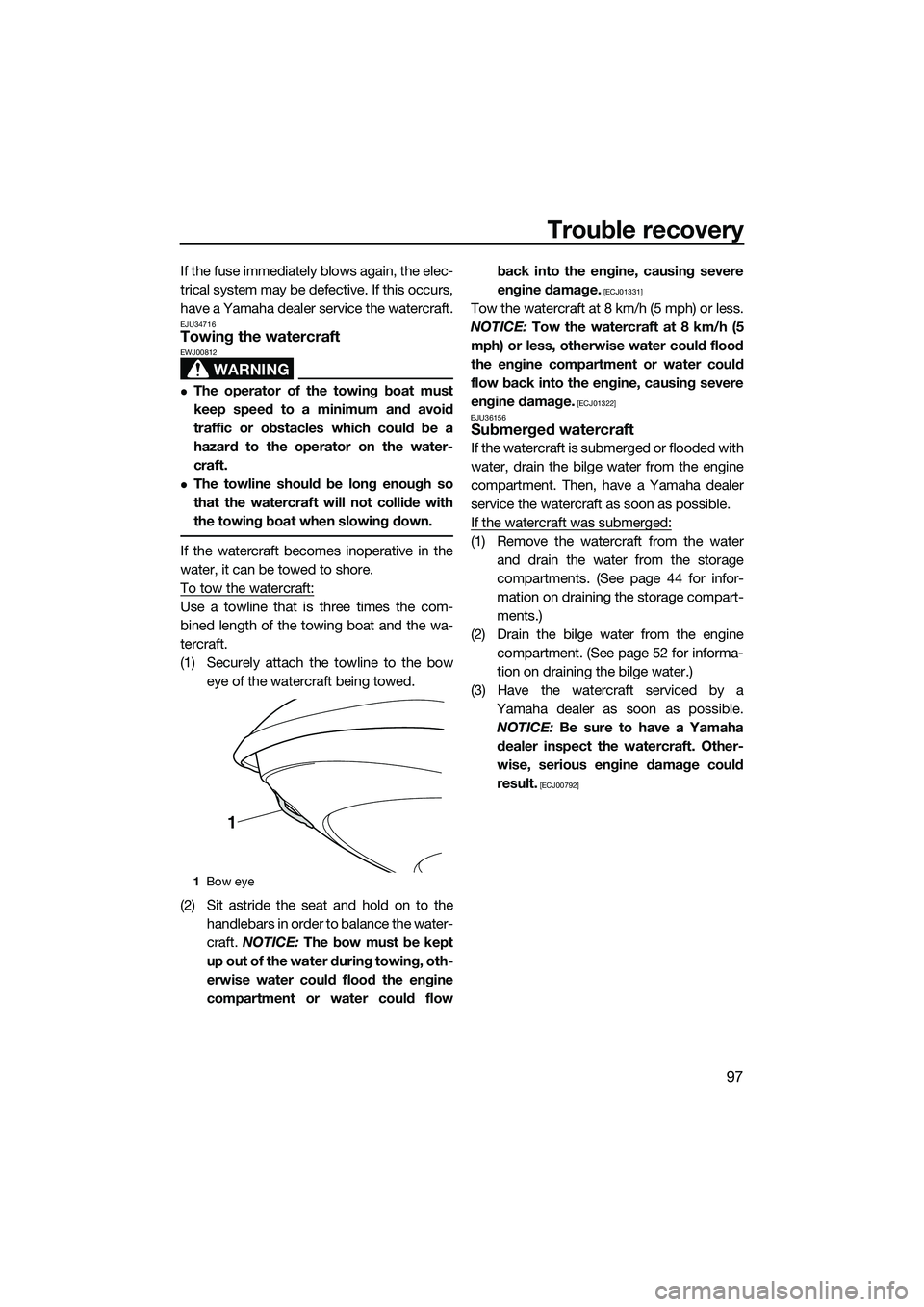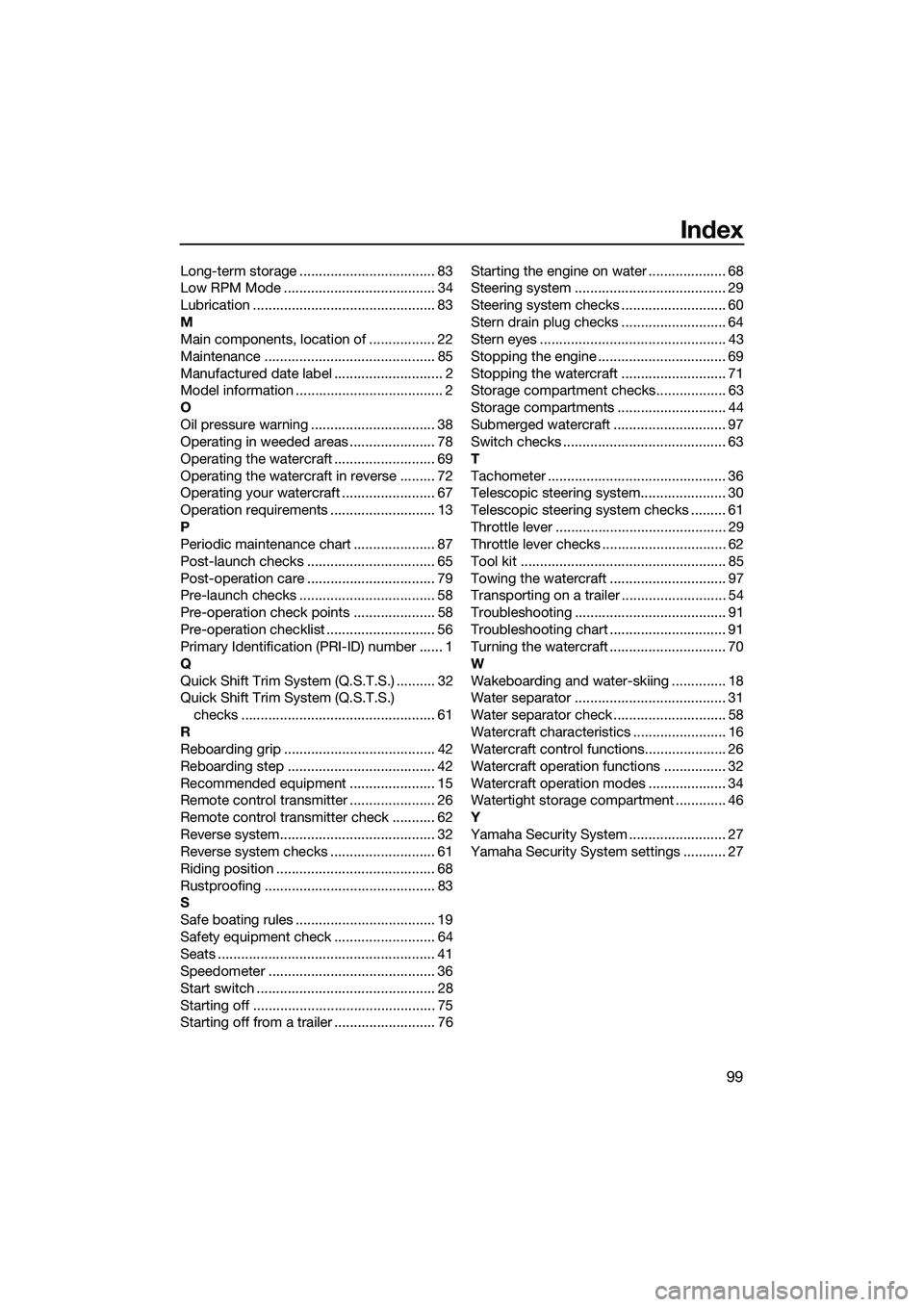2015 YAMAHA FZS SVHO towing
[x] Cancel search: towingPage 6 of 106

Table of contents
Pre-operation check points........... 58
Pre-launch checks ........................... 58
Post-launch checks ......................... 65
Operation ......................................... 67Operating your watercraft ............. 67
Getting to know your watercraft ...... 67
Learning to operate your
watercraft ...................................... 67
Riding position ................................. 68
Launching the watercraft ................. 68
Starting the engine on water ............ 68
Stopping the engine ......................... 69
Leaving the watercraft...................... 69
Operating the watercraft .................. 69
Turning the watercraft ...................... 70
Stopping the watercraft ................... 71
Operating the watercraft in reverse .......................................... 72
Boarding the watercraft ................... 72
Starting off........................................ 75
Capsized watercraft ......................... 76
Beaching and docking the watercraft ...................................... 77
Operating in weeded areas .............. 78
After removing the watercraft from the water ....................................... 78
Care and storage............................. 79Post-operation care ...................... 79
Flushing the cooling water
passages....................................... 79
Cleaning the watercraft .................... 80
Battery care ...................................... 80
Long-term storage ........................ 83
Cleaning ........................................... 83
Lubrication ....................................... 83
Rustproofing..................................... 83
Maintenance .................................... 85 Maintenance.................................. 85
Tool kit.............................................. 85
Removing and installing the engine
cover ............................................. 85 Periodic maintenance chart ............. 87
Engine oil and oil filter ...................... 89
Specifications .................................. 90
Specifications ............................... 90
Trouble recovery ............................. 91 Troubleshooting ............................ 91
Troubleshooting chart ...................... 91
Emergency procedures ................ 94
Cleaning the jet intake and
impeller ......................................... 94
Jumping the battery ......................... 95
Replacing the fuses .......................... 95
Towing the watercraft....................... 97
Submerged watercraft ..................... 97
Index................................................. 98
UF3K71E0.book Page 2 Monday, August 18, 2014 2:54 PM
Page 25 of 106

Safety information
19
er’s or water-skier’s ability, as well as water
and weather conditions.
When preparing to pull a wakeboarder or
water-skier, operate the watercraft at the
slowest possible speed until the watercraft
is well away from the person being pulled
and slack in the ski rope is taken up. Make
sure that the rope is not looped around
anything.
After checking that the wakeboarder or wa-
ter-skier is ready and that there is no traffic
or other obstacles, apply enough throttle to
raise the person.
Make smooth, wide turns. The watercraft is
capable of very sharp turns, which could
exceed the abilities of the wakeboarder or
water-skier. Keep the person being towed
at least 50 m (164 ft), about twice the dis-
tance of a standard ski rope, away from
any potential hazard.
The operators of boats and other water-
craft may not be aware that you are pulling
a wakeboarder or water-skier. Together
with the spotter, pay attention to others
around you and cruise at safe speeds.
Be alert to the hazard of the ski rope handle
snapping back at the watercraft when the
wakeboarder or water-skier falls or is un-
able to get up.
Towing heavy or bulky objects other than
wakeboarders or water-skiers, such as an-
other boat or watercraft, can cause loss of
steering control and create a hazardous
condition. If you must tow another boat in
an emergency situation, operate slowly
and cautiously.
EJU30971
Safe boating rules
Your Yamaha watercraft is legally considered
a powerboat. Operation of the watercraft
must be in accordance with the rules and
regulations governing the waterway on which
it is used.
UF3K71E0.book Page 19 Monday, August 18, 2014 2:54 PM
Page 49 of 106

Equipment operation
43
reboarding step to lift the watercraft. The
reboarding step is not designed to support
the watercraft’s weight. If the reboarding
step breaks, the watercraft could fall,
which could result in severe injury.
[EWJ01212]
NOTICE
ECJ00743
Use the reboarding step only to board the
watercraft in the water. Do not use the re-
boarding step for any other purpose. The
watercraft can be damaged.
EJU34873Bow eye
The bow eye is used to attach a rope to the
watercraft when transporting, mooring, ortowing it in an emergency. (See page 97 for
information on towing the watercraft.)
EJU34882Stern eyes
The stern eyes are used to attach a rope to
the watercraft when transporting or mooring
it.
EJU40422Cleat
The cleat is used to attach a ski rope to the
watercraft when pulling a wakeboarder or
water-skier.
WARNING! Do not use the
cleat to lift the watercraft. The cleat is not
designed to support the watercraft’s
weight. If the cleat breaks, the watercraft
1 Reboarding step
1
1Bow eye
1 Stern eye
1
1
UF3K71E0.book Page 43 Monday, August 18, 2014 2:54 PM
Page 83 of 106

Operation
77
To upright the watercraft:
(1) Remove the clip from the engine shut-offswitch.
(2) Swim to the rear of the watercraft. Turn the watercraft over clockwise by pulling
on the ride plate with your left hand while
pushing down on the gunwale with your
right hand or foot.
If the port (left) side of the capsized wa-
tercraft is tilting up, push down on the
gunwale so that the port (left) side is
down before turning the watercraft
clockwise. NOTICE: Do not turn the
watercraft over counterclockwise,
otherwise water can enter the engine,
which can result in severe damage.
[ECJ00542]
(3) Start the engine and operate the water- craft at planing speed to drain the bilge
water from the engine compartment.
(See page 52 for information on draining the bilge water. If the engine does not
start, see “Towing the watercraft” on
page 97 or “Submerged watercraft” on
page 97.) NOTICE:
Do not run the en-
gine at full throttle for at least 1 minute
after the engine has been restarted.
Bilge water in the engine compart-
ment can splash into the engine,
which can result in severe damage.
[ECJ00554]
EJU42670
Beaching and docking the watercraft
To beach the watercraft:
(1) Make sure that there are no boats, swim- mers, or obstacles near the beach.
(2) Release the throttle lever to reduce speed about 125 m (410 ft) before you
reach the intended beaching area.
(3) Slowly approach the beach and stop the engine just before reaching land.
WARNING! You need throttle to steer. Shutting the engine off can cause you
to hit an obstacle you are attempting
to avoid. A collision could result in se-
vere injury or death.
[EWJ00602] NOTICE:
Never run the engine in water that is
less than 60 cm (2 ft) deep from the
bottom of the watercraft, otherwise
pebbles or sand could be sucked into
the jet intake, causing impeller dam-
age and engine overheating.
[ECJ00473]
( 4 ) G e t o f f t h e w a t e r c r a f t a n d p u l l i t u p o n t h e beach.
To dock the watercraft:
(1) Make sure that there are no boats, swim- mers, or obstacles near the dock.
(2) Release the throttle lever to reduce speed about 125 m (410 ft) away from
the dock.
(3) Slowly approach the dock and stop the engine just before coming alongside it.
WARNING! You need throttle to steer.
UF3K71E0.book Page 77 Monday, August 18, 2014 2:54 PM
Page 103 of 106

Trouble recovery
97
If the fuse immediately blows again, the elec-
trical system may be defective. If this occurs,
have a Yamaha dealer service the watercraft.
EJU34716Towing the watercraft
WARNING
EWJ00812
The operator of the towing boat must
keep speed to a minimum and avoid
traffic or obstacles which could be a
hazard to the operator on the water-
craft.
The towline should be long enough so
that the watercraft will not collide with
the towing boat when slowing down.
If the watercraft becomes inoperative in the
water, it can be towed to shore.
To tow the watercraft:
Use a towline that is three times the com-
bined length of the towing boat and the wa-
tercraft.
(1) Securely attach the towline to the boweye of the watercraft being towed.
(2) Sit astride the seat and hold on to the handlebars in order to balance the water-
craft. NOTICE: The bow must be kept
up out of the water during towing, oth-
erwise water could flood the engine
compartment or water could flow back into the engine, causing severe
engine damage.
[ECJ01331]
Tow the watercraft at 8 km/h (5 mph) or less.
NOTICE: Tow the watercraft at 8 km/h (5
mph) or less, otherwise water could flood
the engine compartment or water could
flow back into the engine, causing severe
engine damage.
[ECJ01322]
EJU36156
Submerged watercraft
If the watercraft is submerged or flooded with
water, drain the bilge water from the engine
compartment. Then, have a Yamaha dealer
service the watercraft as soon as possible.
If the watercraft was submerged:
(1) Remove the watercraft from the water and drain the water from the storage
compartments. (See page 44 for infor-
mation on draining the storage compart-
ments.)
(2) Drain the bilge water from the engine compartment. (See page 52 for informa-
tion on draining the bilge water.)
(3) Have the watercraft serviced by a Yamaha dealer as soon as possible.
NOTICE: Be sure to have a Yamaha
dealer inspect the watercraft. Other-
wise, serious engine damage could
result.
[ECJ00792]
1 Bow eye
1
UF3K71E0.book Page 97 Monday, August 18, 2014 2:54 PM
Page 105 of 106

Index
99
Long-term storage ................................... 83
Low RPM Mode ....................................... 34
Lubrication ............................................... 83
M
Main components, location of ................. 22
Maintenance ............................................ 85
Manufactured date label ............................ 2
Model information ...................................... 2
O
Oil pressure warning ................................ 38
Operating in weeded areas ...................... 78
Operating the watercraft .......................... 69
Operating the watercraft in reverse ......... 72
Operating your watercraft ........................ 67
Operation requirements ........................... 13
P
Periodic maintenance chart ..................... 87
Post-launch checks ................................. 65
Post-operation care ................................. 79
Pre-launch checks ................................... 58
Pre-operation check points ..................... 58
Pre-operation checklist ............................ 56
Primary Identification (PRI-ID) number ...... 1
Q
Quick Shift Trim System (Q.S.T.S.) .......... 32
Quick Shift Trim System (Q.S.T.S.) checks .................................................. 61
R
Reboarding grip ....................................... 42
Reboarding step ...................................... 42
Recommended equipment ...................... 15
Remote control transmitter ...................... 26
Remote control transmitter check ........... 62
Reverse system........................................ 32
Reverse system checks ........................... 61
Riding position ......................................... 68
Rustproofing ............................................ 83
S
Safe boating rules .................................... 19
Safety equipment check .......................... 64
Seats ........................................................ 41
Speedometer ........................................... 36
Start switch .............................................. 28
Starting off ............................................... 75
Starting off from a trailer .......................... 76 Starting the engine on water .................... 68
Steering system ....................................... 29
Steering system checks ........................... 60
Stern drain plug checks ........................... 64
Stern eyes ................................................ 43
Stopping the engine ................................. 69
Stopping the watercraft ........................... 71
Storage compartment checks.................. 63
Storage compartments ............................ 44
Submerged watercraft ............................. 97
Switch checks .......................................... 63
T
Tachometer .............................................. 36
Telescopic steering system...................... 30
Telescopic steering system checks ......... 61
Throttle lever ............................................ 29
Throttle lever checks ................................ 62
Tool kit ..................................................... 85
Towing the watercraft .............................. 97
Transporting on a trailer ........................... 54
Troubleshooting ....................................... 91
Troubleshooting chart .............................. 91
Turning the watercraft .............................. 70
W
Wakeboarding and water-skiing .............. 18
Water separator ....................................... 31
Water separator check ............................. 58
Watercraft characteristics ........................ 16
Watercraft control functions..................... 26
Watercraft operation functions ................ 32
Watercraft operation modes .................... 34
Watertight storage compartment ............. 46
Y
Yamaha Security System ......................... 27
Yamaha Security System settings ........... 27
UF3K71E0.book Page 99 Monday, August 18, 2014 2:54 PM